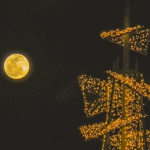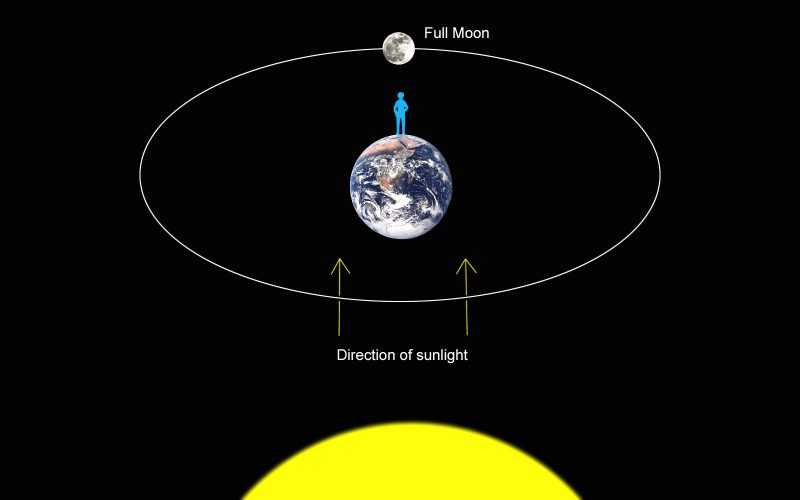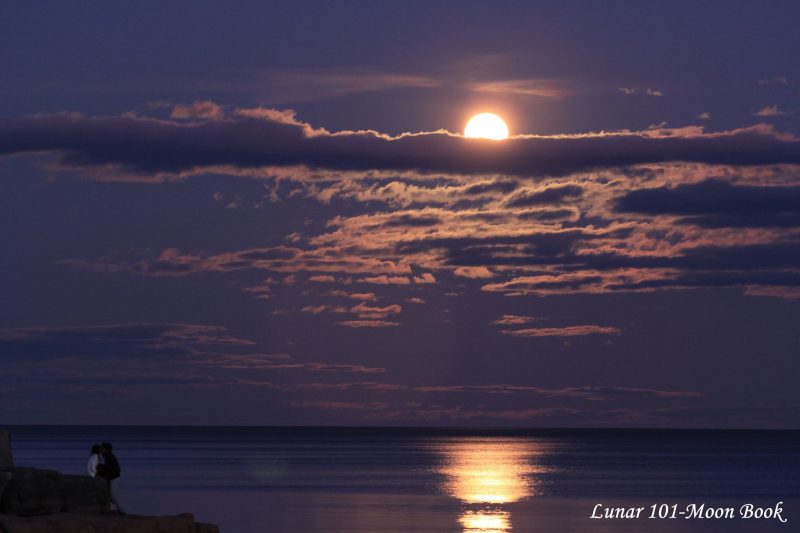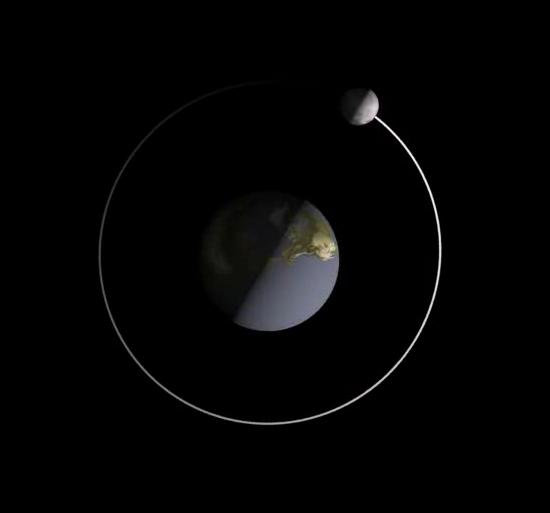

A full moon is opposite the sun. We see all of its dayside. Illustration via Bob King.
The moon appears full to the eye for two to three nights. However, astronomers regard the moon as full at a precisely defined instant, when the moon is exactly 180 degrees opposite the sun in ecliptic longitude. This month, the instant of full moon happens Thursday, October 1, at 21:05 UTC. Translate UTC to your time. A second October full moon occurs on October 31 at 14:49 UTC.
It’s that feature of a full moon – the fact that it’s opposite the sun as viewed from Earth – that causes a full moon to look full.

A kiss under the full moon of November 3, 2017, via our friend Steven Sweet of Lunar 101-Moon Book. He was at Port Credit, a neighborhood in the city of Mississauga, Ontario, Canada … at the mouth of the Credit River on the north shore of Lake Ontario.
Why does a full moon look full? Remember that half the moon is always illuminated by the sun. That lighted half is the moon’s day side. In order to appear full to us on Earth, we have to see the entire day side of the moon. That happens only when the moon is opposite the sun in our sky. So a full moon looks full because it’s opposite the sun.
That’s also why every full moon rises in the east around sunset – climbs highest up for the night midway between sunset and sunrise (around midnight) – and sets around sunrise. Stand outside tonight around sunset and look for the moon. Sun going down while the moon is coming up? That’s a full moon, or close to one.

Click here to see animation. In the linked animation you can see the moon revolving around Earth. Note that the full moon is on the opposite side of the Earth from the sun.
Just be aware that the moon will look full for at least a couple of nights around the instant of full moon.
Read more: What are the full moon names?
Often, you’ll find two different dates on calendars for the date of full moon. That’s because some calendars list moon phases in Coordinated Universal Time, also called Universal Time Coordinated (UTC). And other calendars list moon phases in local time, a clock time of a specific place, usually the place that made and distributed the calendars. Translate UTC to your local time.
Want to know the instant of full moon in your part of the world, as well as the moonrise and moonset times? Visit Sunrise Sunset Calendars, remembering to check the moon phases plus moonrise and moonset boxes.
If a full moon is opposite the sun, why doesn’t Earth’s shadow fall on the moon at every full moon? The reason is that the moon’s orbit is tilted by 5.1 degrees with respect to Earth’s orbit around the sun. At every full moon, Earth’s shadow sweeps near the moon. But, in most months, there’s no eclipse.

A full moon normally passes above or below Earth’s shadow, with no eclipse. Illustration by Bob King.
As the moon orbits Earth, it changes phase in an orderly way. Follow these links to understand the various phases of the moon.
New moon
Waxing crescent moon
First quarter moon
Waxing gibbous moon
Full moon
Waning gibbous moon
Last quarter moon
Waning crescent moon
Bottom line: A full moon looks full because it’s opposite the sun. Its lighted face is turned entirely in Earth’s direction. The next full moon is Thursday, October 1, 2020, at 21:05 UTC. October’s second full moon will fall on October 31.
Read more: Top 4 keys to understanding moon phases
from EarthSky https://ift.tt/2CEamRl


A full moon is opposite the sun. We see all of its dayside. Illustration via Bob King.
The moon appears full to the eye for two to three nights. However, astronomers regard the moon as full at a precisely defined instant, when the moon is exactly 180 degrees opposite the sun in ecliptic longitude. This month, the instant of full moon happens Thursday, October 1, at 21:05 UTC. Translate UTC to your time. A second October full moon occurs on October 31 at 14:49 UTC.
It’s that feature of a full moon – the fact that it’s opposite the sun as viewed from Earth – that causes a full moon to look full.

A kiss under the full moon of November 3, 2017, via our friend Steven Sweet of Lunar 101-Moon Book. He was at Port Credit, a neighborhood in the city of Mississauga, Ontario, Canada … at the mouth of the Credit River on the north shore of Lake Ontario.
Why does a full moon look full? Remember that half the moon is always illuminated by the sun. That lighted half is the moon’s day side. In order to appear full to us on Earth, we have to see the entire day side of the moon. That happens only when the moon is opposite the sun in our sky. So a full moon looks full because it’s opposite the sun.
That’s also why every full moon rises in the east around sunset – climbs highest up for the night midway between sunset and sunrise (around midnight) – and sets around sunrise. Stand outside tonight around sunset and look for the moon. Sun going down while the moon is coming up? That’s a full moon, or close to one.

Click here to see animation. In the linked animation you can see the moon revolving around Earth. Note that the full moon is on the opposite side of the Earth from the sun.
Just be aware that the moon will look full for at least a couple of nights around the instant of full moon.
Read more: What are the full moon names?
Often, you’ll find two different dates on calendars for the date of full moon. That’s because some calendars list moon phases in Coordinated Universal Time, also called Universal Time Coordinated (UTC). And other calendars list moon phases in local time, a clock time of a specific place, usually the place that made and distributed the calendars. Translate UTC to your local time.
Want to know the instant of full moon in your part of the world, as well as the moonrise and moonset times? Visit Sunrise Sunset Calendars, remembering to check the moon phases plus moonrise and moonset boxes.
If a full moon is opposite the sun, why doesn’t Earth’s shadow fall on the moon at every full moon? The reason is that the moon’s orbit is tilted by 5.1 degrees with respect to Earth’s orbit around the sun. At every full moon, Earth’s shadow sweeps near the moon. But, in most months, there’s no eclipse.

A full moon normally passes above or below Earth’s shadow, with no eclipse. Illustration by Bob King.
As the moon orbits Earth, it changes phase in an orderly way. Follow these links to understand the various phases of the moon.
New moon
Waxing crescent moon
First quarter moon
Waxing gibbous moon
Full moon
Waning gibbous moon
Last quarter moon
Waning crescent moon
Bottom line: A full moon looks full because it’s opposite the sun. Its lighted face is turned entirely in Earth’s direction. The next full moon is Thursday, October 1, 2020, at 21:05 UTC. October’s second full moon will fall on October 31.
Read more: Top 4 keys to understanding moon phases
from EarthSky https://ift.tt/2CEamRl

Aucun commentaire:
Enregistrer un commentaire